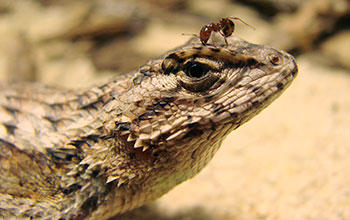Multimedia Gallery
Fence lizard with fire ant
Researchers at Penn State University studying the stress response of fence lizards to non-lethal stress levels from fire-ant exposure in a controlled area speculate that a combination of causes may have overwhelmed the lizards' ability to manage stress, like blowing a fuse in a power surge.
More about this image
It is known that lizards living in fire-ant-invaded areas are stressed. However, a team of biologists from Penn State University found that the lizards did not exhibit this stress as expected after extended fire ant exposure in socially stressful environments, leading to questions about stress overload.
"After encounters with non-lethal stress levels [from fire-ant exposure], we asked, okay, they [the lizards] live, but what happens then?" said Tracy Langkilde, a professor of biology at Penn State. "Do they live and are fine? Do they live and remain stressed? We just don't know."
Previous research by Langkilde found that lizards in fire-ant-invaded areas have elevated stress levels in their natural habitats, but did not pinpoint the cause of that stress. Now, Langkilde and her colleagues wanted to know the short- and long-term physiological effects on fence lizards due to invading fire ants.
To find out, the researchers conducted two experiments to test fence lizards' stress response to non-lethal exposure to fire ants. First, they looked at the impact on stress physiology immediately after short, fire-ant exposure and found that although fire ants did cause stress in these staged encounters, this did not prove that fire ants were the cause of elevated stress seen in nature.
"The direct experiment shows that fire ants are stressors," Langkilde said, "but it does not rule out other environmental factors that may be contributing to differences in stress in nature. So, we wanted to control the environments as much as possible to isolate fire ants as the causal factor of elevated stress levels."
For their second experiment, the researchers looked at the physiological effects after extended exposure in semi-natural conditions.
The lizards spent two weeks in large, semi-natural enclosures built in a fire-ant-invaded area. Two of the four enclosures had natural levels of fire ants while the other two were made fire-ant free. Enclosures were identical in terms of the number of trees, places to hide or perch, quantity of natural prey and gender balance of lizards. The only controllable difference was the presence -- or lack of -- fire ants in the enclosures.
The researchers expected to measure significantly higher corticosterone (CORT) levels in the blood samples from lizards that had been living with fire ants for two weeks. But the lizards from fire-ant enclosures showed significantly lower baseline CORT levels than those from fire-ant-free enclosures.
"This could mean that these lizards were not stressed out by fire ants -- which is not likely," Langkilde said. "But it could also mean that something has gone wrong with their stress-control system."
This research was supported by the National Science Foundation (grants IOS 1051367 and DEB 0949483).
Read more in the Penn State news story Lizards may be overwhelmed by fire ants and social stress combined. (Date image taken: October 2017; date originally posted to NSF Multimedia Gallery: Feb. 27, 2018)
Credit: Tracy Langkilde and Travis Robbins, Department of Biology, The Pennsylvania State University
See other images like this on your iPhone or iPad download NSF Science Zone on the Apple App Store.
Images and other media in the National Science Foundation Multimedia Gallery are available for use in print and electronic material by NSF employees, members of the media, university staff, teachers and the general public. All media in the gallery are intended for personal, educational and nonprofit/non-commercial use only.
Images credited to the National Science Foundation, a federal agency, are in the public domain. The images were created by employees of the United States Government as part of their official duties or prepared by contractors as "works for hire" for NSF. You may freely use NSF-credited images and, at your discretion, credit NSF with a "Courtesy: National Science Foundation" notation.
Additional information about general usage can be found in Conditions.
Also Available:
Download the high-resolution JPG version of the image. (1.5 MB)
Use your mouse to right-click (Mac users may need to Ctrl-click) the link above and choose the option that will save the file or target to your computer.



